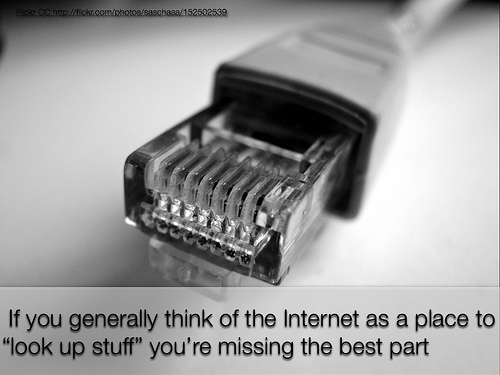
Photo source: George Balanchine’s Apollo – David Ingram & Traci Gilchrest – photo by Peter Zay
Trust.
It’s such a vast concept. Galactic even.
Unit 2 of Connected Courses raised these questions:
In the quantum learning space where interest is a key driver, how do we employ the same dynamics in our teaching? Or, how do we leverage the power of open? How do we maintain trust and a sense of security in open networks? How do we build our networks? What is social capital? How do we enable at-large learners to engage in our courses? Where should we teach our classes?
I started my pre-thinking by focusing on ‘trust’ as a general concept in my own understanding.
My reflections over the last week or so have been fuzzy, but now I think it’s time to attempt some kind of personal definition of trust in open networks, especially if I’m advocating these spaces to teachers.
Trust – we can talk about this from so many perspectives.
One of the difficulties of trusting in people you connect with online is the problem of not seeing them face to face, or not hearing what they have to say on a regular basis as we would with people we work with daily. I think we read visual clues about people without even thinking about it, even though some of our assumptions are not always based on scientific observation.
It’s also very difficult to read tone in text. You don’t always know for sure if people genuinely mean what they say, or if they are saying what you think they mean. This relates to people you know well in real life too. I go in and out of being sure that I know where people are coming from, especially online, and that’s part of the whole trust issue in open networks.
I usually stay away from self promoters while being aware that I may be coming across as one myself. I suppose I keep some sort of distance from people who don’t give back, that is, share things others have said without giving something themselves. This is not trust with a capital T: you don’t fear these people but you might not want them in your inner circle.
So, to state the obvious, to trust someone you have to know them to some degree. Trust is knowing someone well enough to make a judgement that they are someone you are willing to interact with.
Having said that, I ask a question: how do you know someone online?There is no simple answer, and I still don’t know. Maybe I rely on instinct?
Perhaps I warm to people who have similar interests? I’m in awe of people who have superior or expert knowledge, and so I trust them enough to learn from them. I think trust requires an openness, and a transparency, so that I can peek inside the person a little.
Who do I trust to be in my inner circle? (Haha, inner circle sounds very mystical and elitist). How can I trust that what they share is credible? Of course, it’s up to us to evaluate what others post online but I think that once you have a clear picture of their background and credentials, you can trust their shared knowledge. That’s why it’s important to provide a reference point for people in the form of a short biography, blog(s), Twitter handle, Google+ profile or similar.
So, turning the issue of trust around to me –
How can people trust that what I share with them is good quality and worth looking at?
This is a very important professional question for me: How can I build my trust as a teacher librarian who regularly shares online resources? Trust is at the core of everything that I do, and it’s been instrumental in the way I have developed my digital profile. I’ve made myself transparent online, which means interested people can check my bio, blogs, google+, twitter, etc.
My personal professional blog hopefully shows I’m serious about education. I’ve provided opportunities for people to contact me if they want dialogue through email and comments in many of my networks. When I share educational resources, I’m open to talk to teachers if they have any queries.
Why do we want to be trusted online? Some people might think it a strange question. They might think it’s nobody’s business but their own who they are even if they have an online profile. What if people want to be on Facebook, for example, so that they can see what their friends are up to but don’t want to reveal much of themselves?
I think that what you gain from a connected community will determine how much you get from it. To be accepted and considered a valuable participant requires trust, and then a continued demonstration that you can be trusted, for example, to behave respectfully, not to take over at the expense of community balance, to listen as well as contributing, to make an effort to contribute as well as taking from others.
It’s important to be yourself, to add value to the community, to share your unique perspective. If I’m hoping to be accepted as a valuable member of a community, people should be able to trust that I won’t be lazy and just piggy-back others. That is to say, it’s okay for me to retweet and share others’ stuff because I’m in awe of it or excited about it and want to share with others, but I also need to balance that out with my own contribution – and often that just means sharing my unique perspective on things.
From my observations, the best connected networks consist of people who are not afraid to be themselves, who push past the platitudes that sometimes make sameness in online communities undesirable or boring.
Admission:
Yes, I admit, I’m guilty of being lazy sometimes, of sharing of others’ resources without the value added comments, and I will try to add value each time with my own perspective, by sharing Diigo annotations, adding my perspective to retweets (although word restriction!), doing the hard work of research and deeper reading to get to the deeper observations which add to the group’s understanding.
Some people might say, I don’t have anything to add that is unique, and to these people I would say:
Trust in yourself. You do have something to add that is unique, and this enables you to become someone real online. In my interaction with people through Connected Courses, I would say there are many people who exemplify this online. Maha Bali stands out for me through her open, encouraging and accepting online interaction, but there are also many others.
Lastly, I think that trust goes hand in hand with being interesting.
Everyone is interesting because there is something about all of us which is unique and which others may be interested in, but it’s important to bring that part of yourself out. I connect with people online who give a little extra detail about themselves because it enables me to picture them eg playing an instrument, cycling, getting worked up about something they care about. Sometimes photos are useful in providing a little window into ourselves. Howard Rheingold gives us many insights into his life and his interests through photos. Of course, it’s up to you how much you want to share about yourself beyond the educational context. I could trust someone online and interact for the purposes of educational exchange but they don’t become real for me until they paint a little more about themselves.
But that’s another thing to think about in another post.



